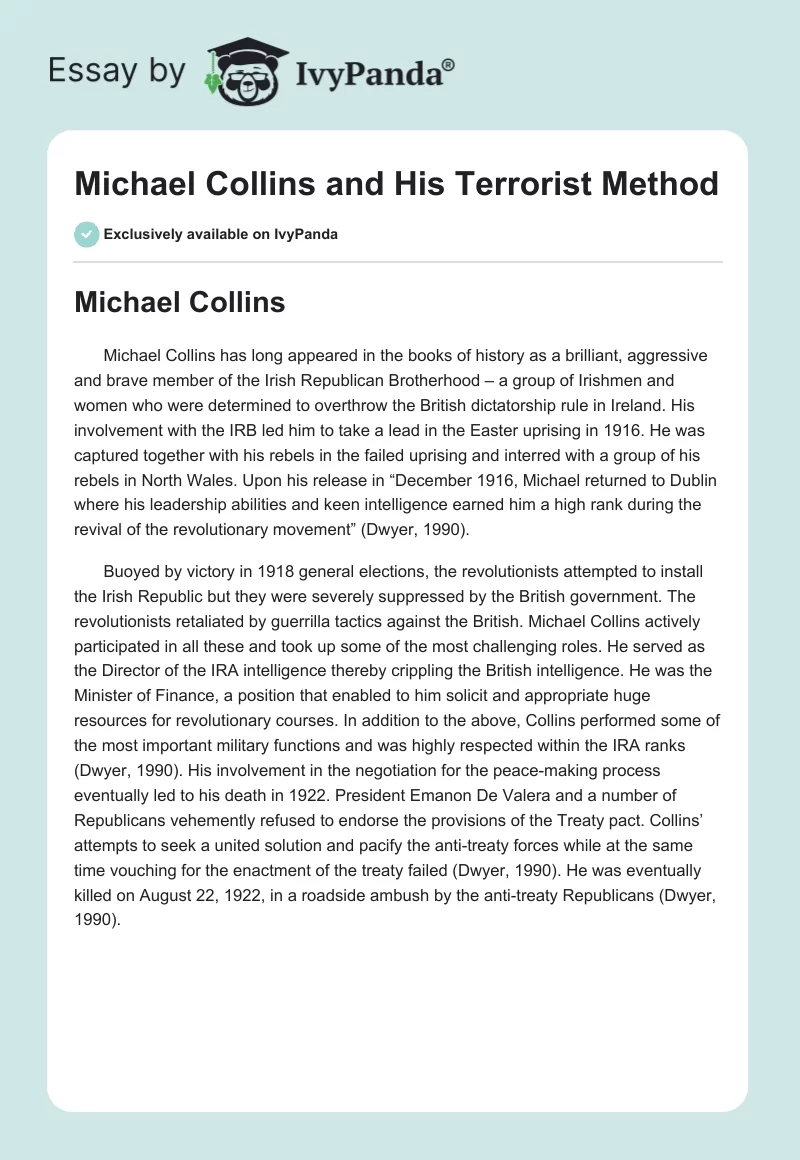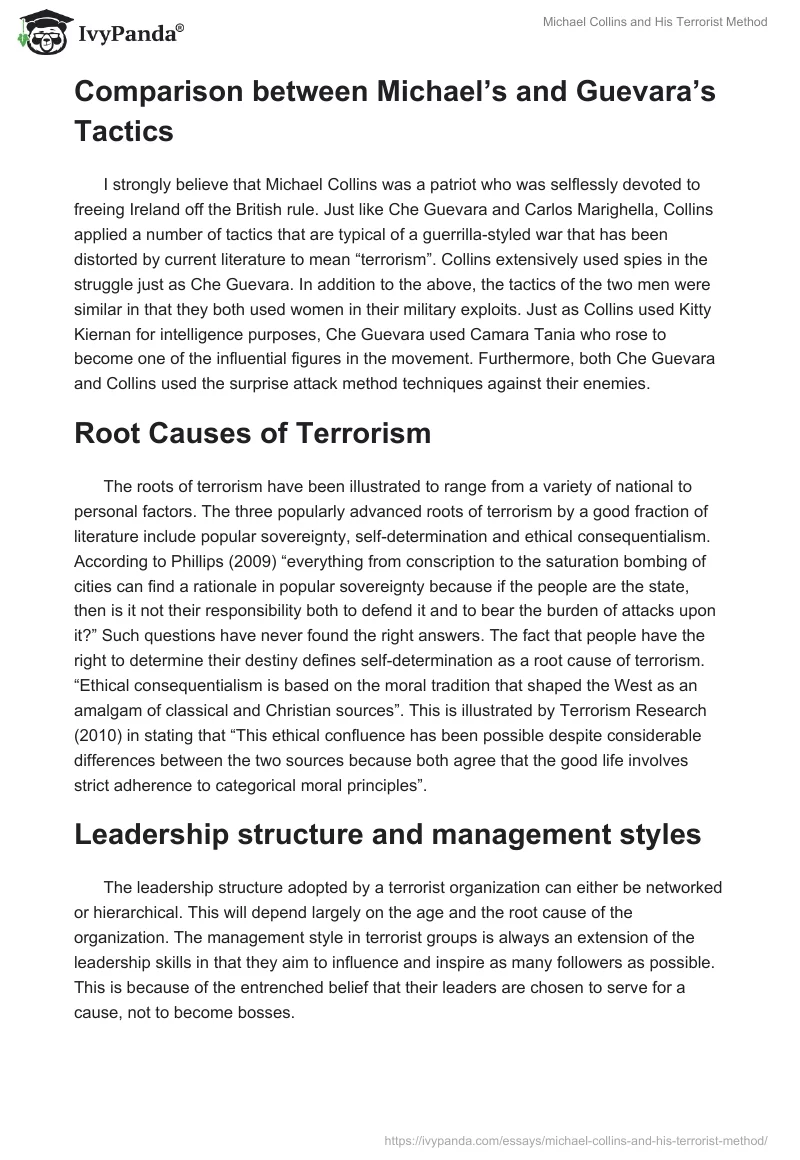Michael Collins
Michael Collins has long appeared in the books of history as a brilliant, aggressive and brave member of the Irish Republican Brotherhood – a group of Irishmen and women who were determined to overthrow the British dictatorship rule in Ireland. His involvement with the IRB led him to take a lead in the Easter uprising in 1916. He was captured together with his rebels in the failed uprising and interred with a group of his rebels in North Wales. Upon his release in “December 1916, Michael returned to Dublin where his leadership abilities and keen intelligence earned him a high rank during the revival of the revolutionary movement” (Dwyer, 1990).
Buoyed by victory in 1918 general elections, the revolutionists attempted to install the Irish Republic but they were severely suppressed by the British government. The revolutionists retaliated by guerrilla tactics against the British. Michael Collins actively participated in all these and took up some of the most challenging roles. He served as the Director of the IRA intelligence thereby crippling the British intelligence. He was the Minister of Finance, a position that enabled to him solicit and appropriate huge resources for revolutionary courses. In addition to the above, Collins performed some of the most important military functions and was highly respected within the IRA ranks (Dwyer, 1990). His involvement in the negotiation for the peace-making process eventually led to his death in 1922. President Emanon De Valera and a number of Republicans vehemently refused to endorse the provisions of the Treaty pact. Collins’ attempts to seek a united solution and pacify the anti-treaty forces while at the same time vouching for the enactment of the treaty failed (Dwyer, 1990). He was eventually killed on August 22, 1922, in a roadside ambush by the anti-treaty Republicans (Dwyer, 1990).
Comparison between Michael’s and Guevara’s Tactics
I strongly believe that Michael Collins was a patriot who was selflessly devoted to freeing Ireland off the British rule. Just like Che Guevara and Carlos Marighella, Collins applied a number of tactics that are typical of a guerrilla-styled war that has been distorted by current literature to mean “terrorism”. Collins extensively used spies in the struggle just as Che Guevara. In addition to the above, the tactics of the two men were similar in that they both used women in their military exploits. Just as Collins used Kitty Kiernan for intelligence purposes, Che Guevara used Camara Tania who rose to become one of the influential figures in the movement. Furthermore, both Che Guevara and Collins used the surprise attack method techniques against their enemies.
Root Causes of Terrorism
The roots of terrorism have been illustrated to range from a variety of national to personal factors. The three popularly advanced roots of terrorism by a good fraction of literature include popular sovereignty, self-determination and ethical consequentialism. According to Phillips (2009) “everything from conscription to the saturation bombing of cities can find a rationale in popular sovereignty because if the people are the state, then is it not their responsibility both to defend it and to bear the burden of attacks upon it?” Such questions have never found the right answers. The fact that people have the right to determine their destiny defines self-determination as a root cause of terrorism. “Ethical consequentialism is based on the moral tradition that shaped the West as an amalgam of classical and Christian sources”. This is illustrated by Terrorism Research (2010) in stating that “This ethical confluence has been possible despite considerable differences between the two sources because both agree that the good life involves strict adherence to categorical moral principles”.
Leadership structure and management styles
The leadership structure adopted by a terrorist organization can either be networked or hierarchical. This will depend largely on the age and the root cause of the organization. The management style in terrorist groups is always an extension of the leadership skills in that they aim to influence and inspire as many followers as possible. This is because of the entrenched belief that their leaders are chosen to serve for a cause, not to become bosses.
Motives and Goals
The motives and goals of terrorists vary on their root causes. These may range from religious fundamentalism to political causes such as the case of Hamas. In addition to that, goals and motives will be largely influenced by ideologies and motivations. According to Phillips (2009) “groups with secular ideologies and non-religious goals will often attempt highly selective and discriminate acts of violence to achieve a specific political aim.” Their aims, therefore, vary from freeing prisoners, obtaining recognition, satisfying the vengeance or even inflicting high levels of fear. Last, the relationship between media and terrorist organizations has been a frosty one. This relationship has been described as “symbolic in that terrorist organizations use the media as a conduit for their political message to be heard by their target while at the same time supplying interesting news to the media” TerrorismResearch (2010). The root cause and aims of terrorist organizations form the important factors in determining the areas of operation and the tactics they are likely to employ in their acts of terror.
Conclusion
The analysis of the life of Michael Collins and the comparative analysis of his terrorist method and those of Che Guevara has undoubtedly given a deep insight into the root causes of terrorism, their leadership structures and management styles, their aims and motives and their tactics. Whereas this paper cannot explore all the aspects of terrorism, however, it provides some of the most important information on the controversial topic of terrorism.
References
- Dwyer, T. R. (1990). Michael Collins: the man who won the war. Cork: Mercier Press.
- Phillips, R.L. (2009). The Roots of Terrorism.
- TerrorismResearch. (2010). Goals and Motivations of Terrorists. Web.


